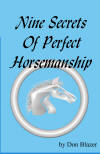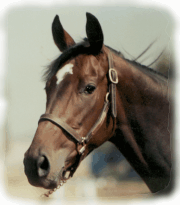
Don Blazer
Archives:
Flying Horses?
Don't eat like a Pig
Parasites
Back Sore?
Goat Hero
Communication
Foals
History of Horses
Jumping Horses
Lameness and Health
Kick the IRS
Meet Don Blazer
Books by Don Blazer
View Our Catalog
Secure Book Order Form
Don Blazer
A Horse, Of Course
Secure Book Order Form
Order using our Secure Order Form

Walter (A Horse, of Course) Spills the Oats
Nine Secrets of Perfect Horsemanship
This is a Secure Web Site
Archives:
Flying Horses?
Don't eat like a Pig
Parasites
Back Sore?
Goat Hero
Communication
Foals
History of Horses
Jumping Horses
Lameness and Health
Kick the IRS
Order using our Secure Order Form
View Our Catalog
This is a Secure Web Site
|
Sometimes I like to pretend Iím the strong, silent type.
When it comes to horses, big mistake.
Horses donít want you to be too strong. If you go macho-man, one of two
bad things happens. The horse proves heís stronger, or the horse gives up.
In either case, the horseís performance is always on the poor side.
If you take the silent approach with a horse, absolutely nothing happens.
If you try to be a horse whisperer, very little happens. (A horseís
hearing range is 55 to 33,500 hertz--meaning a horse doesnít hear as many
low tones as a human does. Donít whisper, speak up.)
I have a friend who says communication is the key to a successful
relationship between a man and a woman.
Is that her way of trying to get me to talk more, or talk less?
I know communication is the key to a successful relationship with a horse.
In fact, communication is all there is to training a horse. The horse
can physically perform all the exercises youíll ever ask of him; you donít
actually teach him how to do any of them. The best you can hope for is to
teach a horse to understand your request for a particular performance, and
that heíll act upon your request.
To begin communicating with a horse you must understand that he doesnít
speak English. (That doesnít make him stupid. I donít think youíre stupid
just because you donít speak piglatin.) In fact, a horse is pretty smart
and he can learn some English, such as "ho," "walk," "trot," "canter,"
"jog" and "lope." He will learn his name, and if used often enough a few
unmentionable words tossed at him in anger. In addition to the English you
teach him, heíll have about 1400 words or body behaviors to express his
opinion about things to you and his friends.
Of course, you also communicate with a horse through the use of your
aids--weight, legs, hands and reins. Hopefully these aids are used to give
subtle yet meaningful cues which the horse identifies as a request for
action. Once the request is understood, as a willing partner, the horse
performs and a happy relationship continues.
As with all learning, confrontation is a requirement.
If a request is made, and the horse does not perform as the trainer would
like, then a confrontation has to take place. The horse has to understand
the action was incorrect. (This is not and never should be abuse.) The
request is made again, and if incorrect action follows, a new confrontation
takes place. The confrontation can be anything appropriate from a thump
with a heel to a forceful tipping of the nose. Stopping all action is a
confrontation which works very well in getting the horseís attention. The
request is made again, and if this time the horse gets the action correct,
praise should follow.
When such a situation occurs between a man and a woman, itís called an
argument. There are only two ways to argue with a woman, and neither
works. It is best to seek out a new understanding of the request, then do
as you are told.
Horses learn that much more quickly than human males.
Communication with a horse, after only a little practice, becomes easy and
very effective. As the partners get better at requesting and
understanding, the communication signals become more and more refined.
Finally, the communication becomes a mental process. The rider thinks of
what he or she wants in a performance, the aids make the request without
conscious direction and the horse performs because he feels and understands
the energy in the request.
One of the keys to reaching that level is to ALWAYS say what you mean and
mean what you say.
If you decide to ask a horse to stop by saying "ho," always say "ho."
Donít say "ho" when you mean "slow, or relax, or half-halt."
Ride a horse in training sessions exactly as you expect to ride the horse
during any performance. That is consistency in communication, another
requirement if learning is to take place. Riding a horse with two hands
during a training session, then switching to one hand a few minutes later
is communication confusion.
And donít try to communicate too many ideas at one time. Work on a single
communication until the horse understands, then give him time to enjoy his
praise and think about what he has done.
When you want to communicate, seek first to understand your partner, then
seek to be understood.
If you work on your communication skills until youíve got them perfected,
I can promise you a lot less talk and a lot more action.
Each month you'll find a new column on our web site. We hope you'll enjoy it, and maybe
e-mail us with questions or suggestions for other
columns. A Horse, Of Course is a weekly column syndicated
by Success Is Easy. If you like the column, call your local newspaper, or local horse
publication and ask them to subscribe by contacting Success Is Easy, 13610 N. Scottsdale Rd., Suite 10-406, Scottsdale, AZ 85254
________________________________
A Horse Of Course |
Horse Books Catalog |
Meet Don Blazer
Ask Don Blazer |
Courses and Clinics |
Horse Training
Horses for Sale |
Who's Walter? |
Horse Links
Home
Info@donblazer.com
Copyright © 2000 by
Don Blazer
Success Is Easy, 13610 N. Scottsdale Rd., Suite 10-406, Scottsdale, AZ 85254
Vanndal Web Designs


